#Rynchops
Text
Black Skimmer (Rynchops niger)
287 notes
·
View notes
Photo
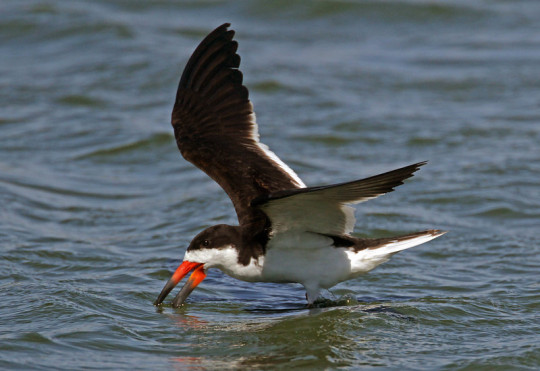
A black skimmer (Rynchops niger) fishes in San Mateo Co., California, USA
by Ron Wolf
#black skimmer#skimmers#seabirds#birds#rynchops niger#rynchops#laridae#Charadriiformes#aves#chordata#wildlife: california#wildlife: usa
243 notes
·
View notes
Text
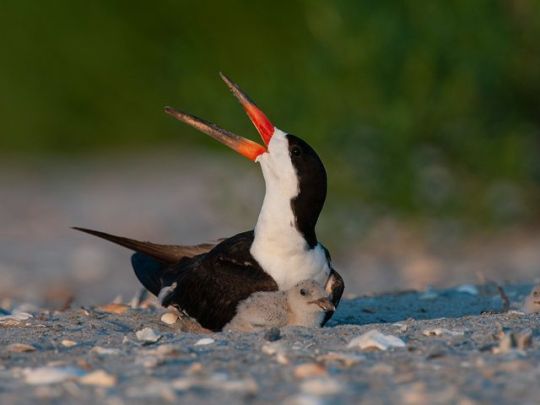
Black Skimmer
28 notes
·
View notes
Text

[869/10,977] Black Skimmer - Rynchops niger
Order: Charadriiformes
Suborder: Lari
Family: Laridae (gulls, terns and skimmers)
Genus: Rynchops (skimmers)
Photo credit: Michiel Oversteegen via Macaulay Library
32 notes
·
View notes
Text

Black Skimmer (Rynchops niger), Rollover Pass, Bolivar Peninsula, Galveston county, Texas.
48 notes
·
View notes
Text

Black Skimmers (Rynchops niger)
Taken at the Sebastian Inlet in Sebastian, FL
#black skimmer#black skimmers#bird#birds#bird photography#bird watching#beach#ocean#animal#animals#animal photography#wildlife#wildlife photography#nature#nature photography#photography#florida#florida photograhy#florida photographer#Sebastian inlet#nikon camera#nikon photography#nikon d3500#Rynchops niger
26 notes
·
View notes
Text
Tide Dancers

Here is a photograph of a bunch of black skimmers (Rynchops niger) at Gulfport, Mississippi. Post one of these every now and again, the last times we were there, I probably took hundreds of pictures of these fascinating birds.
"A long-winged bird with stark black-and-white plumage, the Black Skimmer has a unique grace as it forages in flight. Skimmers feed by opening the bill and dropping the long, narrow lower mandible into the water, skimming along until they feel a fish. Then they relax the neck, quickly closing their jaws and whipping the fish out of the water. Because they feed by essentially by touch, they can even forage at night. The world’s three species of skimmers are the only birds on earth that feed in this manner." - allaboutbirds.org
@birdcounter
#photo#photography#photographer#photographylovers#birds#birdwatching#birdsphotography#birds of north america#birdlovers#birdphotography#black skimmers#bird#birbs#bird photography#bird watching#birding#birdingphotography#birds nature
18 notes
·
View notes
Text
I rewatched The Sword of Life and Death and was once again charmed that Sha Wu Sheng refers to Lin Xue Ya as "Gale" (Ryō in the Japanese dub) which is simultaneously formal and informal in equal measure. It's the short form of Lin's art name, Ryō Fū Setsujin, which the official English subs translate as "The Enigmatic Gale".
Just for fun, I went and looked at the kanji to see what I could learn. Caveat: not a native speaker, just playing around with a JP dictionary; there's probably other subtleties in Mandarin that I am not aware of.
Anyway, Ryō Fū Setsujin is written out as 掠風竊塵, which Wikipedia translates as "Thief of the Wind Dust", but as you can probably imagine, it's a bit more complicated than that.
The first character, 掠, means "pillage" or "rob". It's usually used in compounds, but standing on its own, it's one of the Eight Principles of Yong, referring to specific kinds of calligraphy strokes, all of which are embodied in the character for "eternity" 永 (pronounced yong in Chinese). In the Tang Dynasty, 掠 was known as lüè or 'skim' (among other names); it's the sixth stroke, the sweeping curve at the bottom of the leftmost piece of the character. It's supposed to be drawn quickly, as if skating over the surface.
This dual meaning is preserved in the Japanese verb, 掠める, which means "to steal" but it can also mean "to deceive" or "to touch lightly", "appear or disappear quickly", "to do something while no one is looking" or "to hint and insinuate". In other words, Lin's character in a nutshell.
In English, I'd be tempted to take advantage of the multiple meanings of "skim" ("remove something from liquid" and "embezzle money") and say Sha is calling Lin "Skimmer", which is a little awkward but is also the name of a shorebird, which is fitting since they both have bird motifs. It would also emphasize the transitory nature of their relationship, where Lin is just "passing through" as will as his thieving nature. Skimmers also have a big mouth with the lower beak significantly larger than the top, which is funny because Lin is always talking! Unfortunately, there aren't any species native to China, but Rynchops albicollis can be found further south in Asia, and this is a fantasy world with dragons and monsters, so I'll allow it. "Skimmer" is also slightly classier (and more polite) than a more literal translation like "Thief"; alas, it doesn't fit as well when you add in the rest of the phrase back in.
風 is literally "wind", but with a secondary meaning of "manner" (compare with the English "air", which also has this dual sense). This is partly where Crunchyroll gets "Gale", which I like because Lin is a whirlwind pulling everyone along in his wake.
竊 is "steal, secret, private, hushed" - so once again, we have the thieving aspect coupled with the secrecy, in keeping with Lin's propensity for stealing non-tangible objects and the veil of mystery he operates under. This is where the "Enigmatic" part comes in.
塵 is "dust, trash, garbage" - "Dust" is obviously the more poetic term here, but I personally like the image of Lin as crow ruffling through a dumpster in search of garbage; it suits him. There's a kind of mocking element here; the things Lin steals are worthless in the monetary sense, but they are what his targets value the most, and Lin grinds his victims in the dirt by taking them away. Coupled with the wind imagery, it makes it sound like Lin is a dust devil, kicking up dirt as he goes--conveniently taking us back to "Gale" again. I also appreciate how we now have "trashy" to contrast with the implied elegance elsewhere in the construction.
As you can see, 掠風竊塵 is very challenging to translate succinctly into English; "Thief of Wind Dust" is very literal and covers all the bases ("thief" representing two different characters, lol), while "Enigmatic Gale" is less literal but more poetic in English, and does a better job of capturing the "coolness" inherent in the original. But there's also a lot of subtleties that I wasn't previously aware of; taken together, 掠風竊塵 basically screams "this is a charming but sketchy dude you should not trust", the effect of which is unfortunately lost somewhat in translation.
9 notes
·
View notes
Text

Grzimek's Animal Life Encyclopedia. Volume 6: Reptiles. Written by Bernard Grzimek. 1984.
1.) Blunthead Slug Snake (Aplopeltura boa)
2.) Neo-tropical snail-eater (Dipsas indica)
3.) Dragon snake (Xenodermus javanicus)
4.) Masked water snake (Homalopsis buccata)
5.) Bockadam snake (Cerberus rynchops)
6.) Tentacled snake (Erpeton tentaculatum)
7.) Indian wart snake (Acrochordus granulatus)
#reptiles#snakes#blunthead slug snakes#neo-tropical snail eaters#masked water snakes#bockadam snakes#tentacled snakes#indian wart snakes
198 notes
·
View notes
Text
BRACKET C
Black Skimmer (Rynchops niger)
“They have such tiny beady black eyes, an awkwardly large lower mandible, they just look like a malnourished toucan flipped upside down.” says one nomination. By the way, as well as their eyes being beady, they have slit pupils!
VERSUS
Flamingo (family Phoenicopteridae)
They’re extremophiles! They live in the most boiling acidic water and they do not give a shit! They drink, nest in, and live in boiling, hypersaline, toxic water that will strip a human’s skin away! And they’re pink!
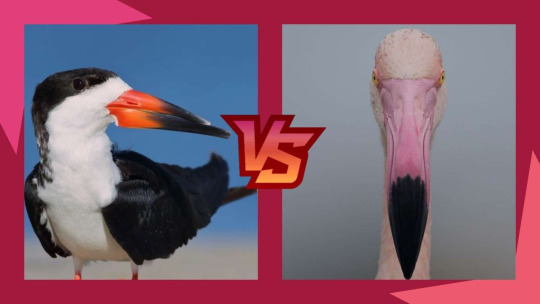
21 notes
·
View notes
Text
GET SWADDLED IDIOT

Black Skimmer (Rynchops niger)
This bird is being handled for research purposes by licensed professionals. It was not injured during this process and was quickly released back to it's colony after being banded!
#almost done with my first week at my new job and it's been great :)#birds birds everywhere#also i live on an island now so that's neat#birds#i speak
17 notes
·
View notes
Text

"Black skimmer (Rynchops niger) fishing in the Pantanal wetland region of Brazil. Skimmers are the only birds with distinctive uneven bills, where the lower mandible is longer than the upper. It allows them to use their amazing fishing technique".
Taken by: Charles J Sharp on 2015-09-06.
Wikimedia Picture of The Day: 2023-01-29.
2 notes
·
View notes
Text
Chiloe and its Migratory Birds

More than 20 migratory bird species come to Chiloe every year. Some come from the south, others from the north and still others from the Andes Mountains. Their favorite spots are coastal marshes like Pullao Wetlands and evergreen forests, where they build nests, rest and feed.
Migration occurs according to changes in climate, availability of food and reproductive needs. It is a seasonal cycle of comings and goings during which these birds seek to take advantage of favorable conditions in different areas.
Migratory birds can be classified into different groups based on their movements:
Boreal Migration: These species leave their nesting spots in the Arctic to travel thousands of kilometers south during the boreal winter. They even turn up in Tierra del Fuego, meaning they have flown from one side of the world to the other. The following birds from this category can be found in Chiloe:
Greater yellowlegs (tringa melanoleuca): This bird arrives from the Arctic to South America each summer. In Chiloe it is usually found alone or in small groups eating invertebrates in streams and along the shore in areas with protective plant cover.
Baird’s sandpiper (calidris bairdii): This frequent visitor arrives to Chiloe in the summer and moves along interior coasts in flocks of 10 to 20 birds. It can also be found along beaches on the open sea.
Eurasian whimbrel (numenius phaeopus): This is one of the most common migratory species during Chiloe summers. It is usually found alone when on the beach, while it prefers groups of hundreds in marshes. It travels from Alaska and Canada to Tierra del Fuego.
Hudsonian godwit (limosa haemastica): This is the bird that escapes the boreal forest winter in the largest numbers to come Chiloe. The marshes on the eastern side of the archipelago are its main feeding grounds. An estimated 20% of the world population of Hudsonian godwits is found at Pullao Wetlands.
Western osprey (pandion haliaetus): This raptor arrives to Chiloe from the southern-central United States in search of fish especially from large inland rivers.
Ruddy turnstone (arenaria interpres): This is a beautiful, but scarce, Chiloe shorebird. These can be found in small flocks feeding near the water. If you are patient and lucky, you might see them turning over rocks to find their food.

Neotropical Migration: This group migrates from the southern United States, Mexico, Central America and northern South America. The following species can be found in Chiloe:
White-crested elaenia (elaenia albiceps): This is the only neotropical migratory species that nests in Chiloe during the summer. It arrives in October and leaves the archipelago in April to return to the Amazon in Brazil.
Black skimmer (rynchops niger): This bird arrives to Chile from the neotropics in October where it spreads out among the marshes of the Archipelago of Chiloe. It is known for leaving a showy wake as it forages in flight.
Austral Migration: This group includes the species that nest in the southern cone, especially in the region of Chilean and Argentine Patagonia. These birds migrate north during the fall and winter months. Birds of this type found in Chiloe are:
Two-banded plover (charadrius falklandicus): This small shorebird migrates from Tierra del Fuego to Chiloe during the winter. It then returns to extreme southern Chile to nest. Some groups stay in northern areas all year.
Rufous-chested plover (charadrius modestus): This is one of the most common visitors to the Chiloe coast in winter. It feeds in tidal flats, such as Pullao Wetlands, hunting for invertebrates during the low tide.
Silvery grebe (podiceps occipitalis): This small, water bird enjoys diving in the waters of the archipelago of Chiloe until October. In the winter, it nests in the freshwater lakes of Patagonia.
Chilean flamingo (phoenicopterus chilensis): This is definitely one of Chiloe’s most striking migratory birds. It arrives from the Patagonia pampa in autumn and stays until August when it heads back to its inland lake breeding areas.
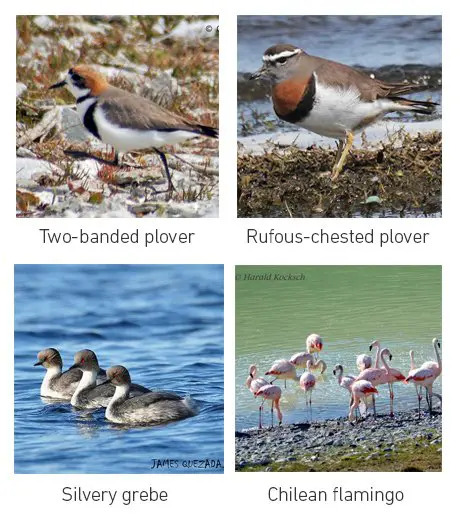
Altitudinal migration: This group includes species that migrate from and toward the Andes Mountains, central valleys and the coast, where they feed before returning to their breeding areas at higher altitudes. The following species of this type can be found in Chiloe:
Dark-faced ground tyrant (muscisaxicola macloviana): This bird migrates during winter throughout Chile at different times and in varying directions. Then it returns to the foothills above the tree line for reproduction.
Grey-flanked cinclodes (cinclodes oustaleti): This bird is often found feeding in urban areas. It travels from the mountains to the coast during the winter and stays there between April and October.
Patagonia tyrant (colorhamphus parvirostris): This bird migrates from the wooded foothills in southern Chile to the north and sea-level forests to avoid the winter cold and snow. It stays in Chiloe until spring when it returns to its nesting grounds.
It is likely that you will see some of these migratory species during the excursions offered by Tierra Chiloé. If you are interested in birdwatching, our guides are well trained to help you birdwatch in a way that is respectful toward the environment. Whether you are an expert or novice, this experience will connect you to nature in a very special way.
0 notes
Photo


Black Skimmer
38 notes
·
View notes
Photo

[93/10,976] African Skimmer - Rynchops flavirostris
Order: Charadriiformes
Suborder: Lari
Family: Laridae
Genus: Rynchops (skimmers)
Photo credit: Jose Martin via Macaulay Library
11 notes
·
View notes
Photo
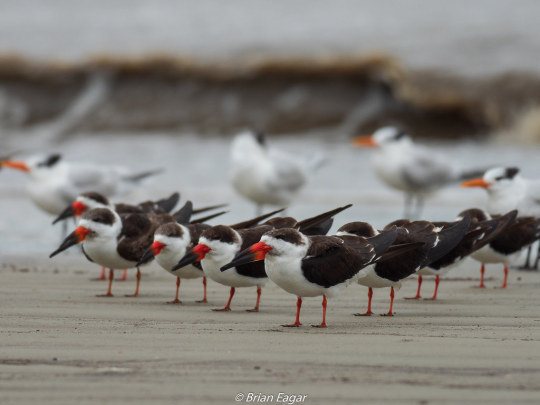
Black Skimmer (Rynchops niger)
© Brian Eagar Nature Photography
14 notes
·
View notes
